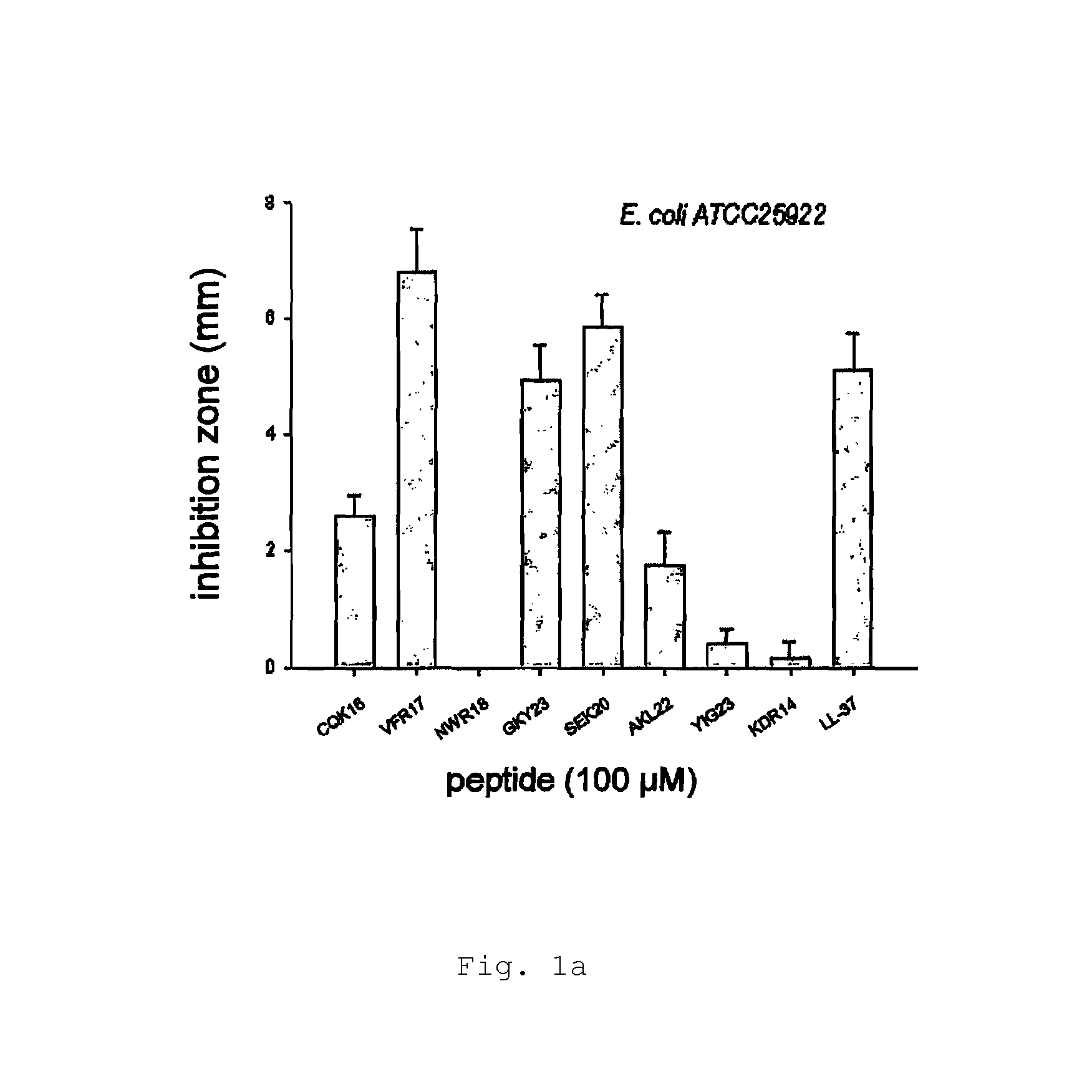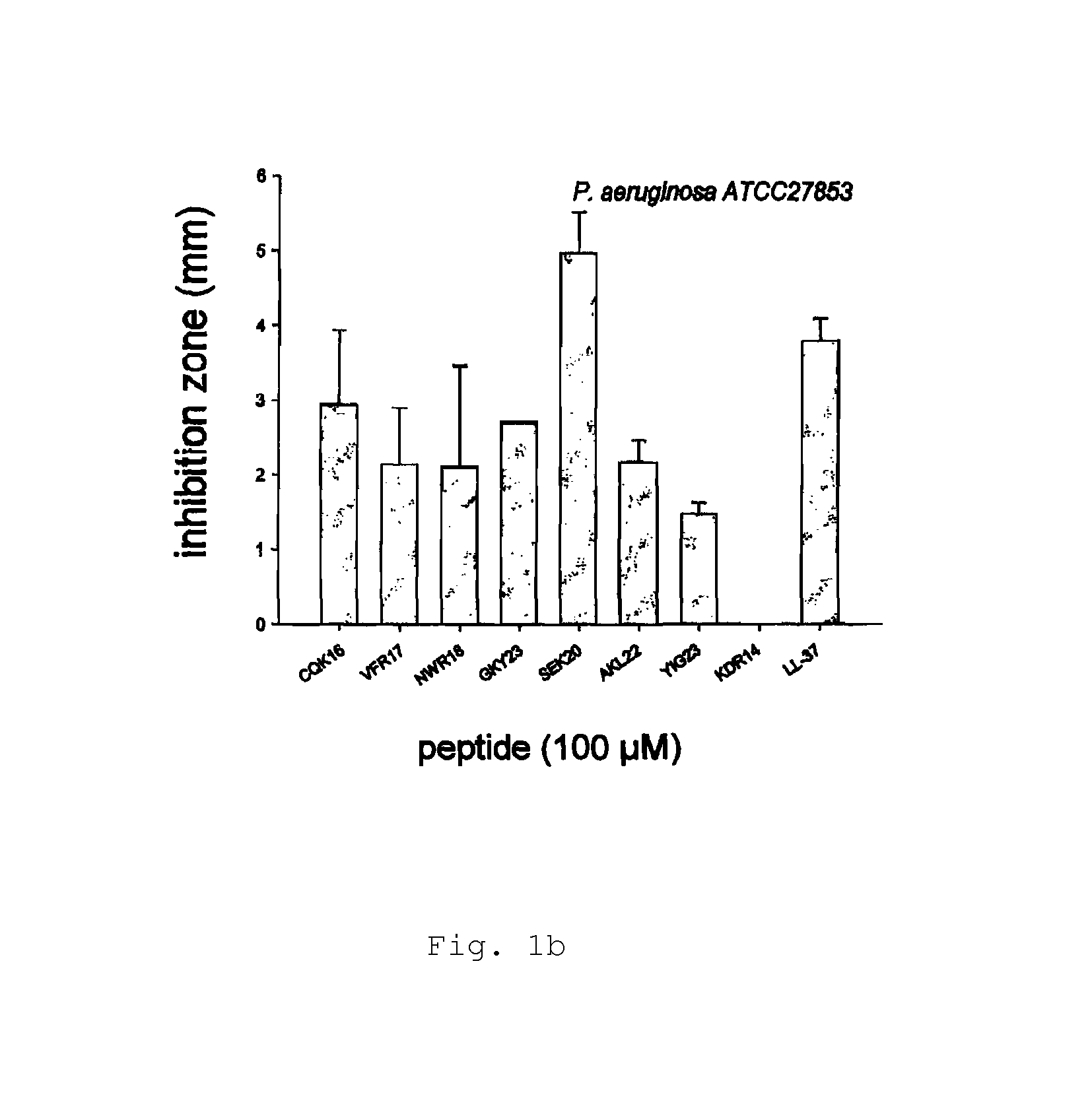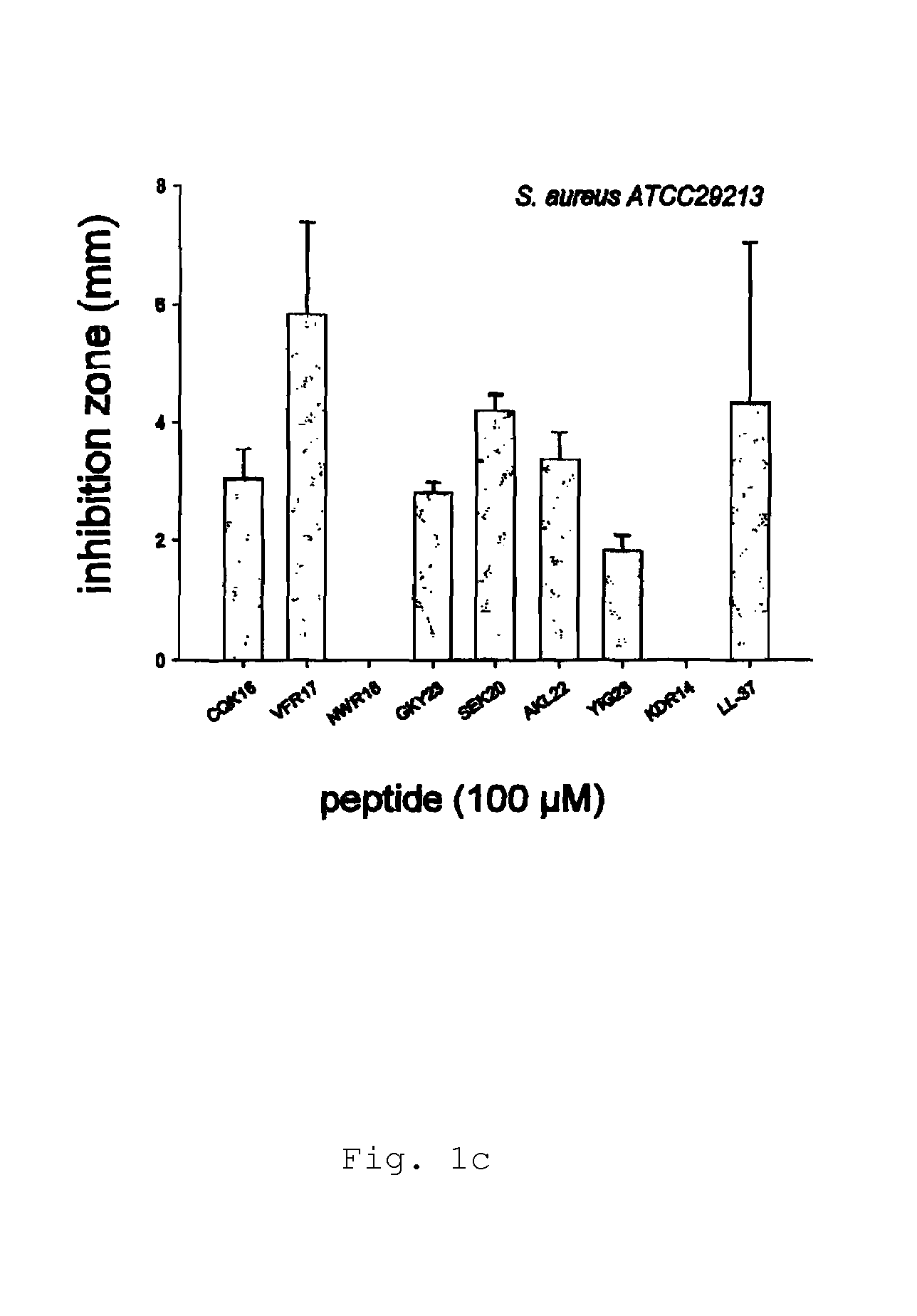Antimicrobial peptides and use thereof
a technology of antimicrobial peptides and peptides, which is applied in the direction of antibacterial agents, peptide/protein ingredients, drug compositions, etc., can solve the problems of impaired skin barrier function, localised or generalised acute infections, and vaccines are not always the best treatment option
- Summary
- Abstract
- Description
- Claims
- Application Information
AI Technical Summary
Benefits of technology
Problems solved by technology
Method used
Image
Examples
example 1
[0131]Identification of the Peptide Structure of the Antimicrobial Peptides Derived from Human Proteases
[0132]70 human proteases were identified and the amino acid sequences compared to each other.
[0133]The carboxy terminus in all these proteins ends with an α-helix, which have been shown to exhibit antimicrobial activity.
[0134]The following common amino acid sequence motif was derived from the α-helices.
X(2)-[PFY]-X(2)-[AFY]-[AITV]-X-[ILV]-X(5)-W-[IL]-X(3,32)>
[0135]Limiting the comparison to covering solely eight human coagulation factors as defined below one following common amino acid sequence motif was derived
{DS}-X-[PFY]-G-[FIV]-Y-T-X-V-{C}-[AEQRY]-X-{R}-X-W-[IL]-X-{H}-X(4,24)>
[0136]
TABLE 1Carboxy terminal antimicrobial sequences from the eight human coagulation factorsbelonging to the peptidase S1 family found with the narrow motif.
[0137]The above, defined peptides also contain a disulfide-bonded loop approximately 55 residues further amino terminal of the carboxy terminal a-h...
example 2
Antimicrobial Peptides
[0140]The peptides were synthesised by Innovagen AB, Ideon, SE-22370, Lund, Sweden. The purity (>95%) and molecular weight of these peptides was confirmed by mass spectral analysis (MALDI.TOF Voyager) (see table 2).
[0141]
TABLE 2Antimicrobial peptides used in the study.Name and numbering according to the unprocessed precursor in the Uni-ProtKB / Swiss-Prot entry (www.expasy.org / sprot / ).ProteinSequenceDesignationSEQ ID NOFA11_HUMAN aa 545-560CQKRYRGHKITHKMICCQK16SEQ ID NO: 58THRB_HUMAN aa 606-622VFRLKKWIQKVIDQFGEVFR17SEQ ID NO: 1THRB_HUMAN aa 454-471NWRENLDRDIALMKLKKPNWR18SEQ ID NO: 60FA9_HUMAN aa 439-461GKYGIYTKVSRYVNWIKEKTKLTGKY23SEQ ID NO: 61IPSP_HUMAN aa 283-302SEKTLRKWLKMFKKRQLELYSEK20SEQ ID NO: 62THRB_HUMANaa 598-622GKYGFYTHVFRLKKWIQKVIDQFGEGKY25SEQ ID NO: 63FA11_HUMANaa 603-625ERPGVYTNVVEYVDWILEKTQAVERP23SEQ ID NO: 64KLKB1 HUMANaa 606-630EQPGVYTKVAEYMDWILEKTQSSDGEQP25SEQ ID NO: 65THRB_HUMANaa 605-622HVFRLKKWIQKVIDQFGEHVF18SEQ ID NO: 66FA11_HUMANaa 610-625NVV...
example 3
[0146]Radial diffusion assays (RDA) were performed essentially as described earlier (Lehrer, R. I., Rosenman, M., Harwig, S. S., Jackson, R. & Eisenhauer, P. (1991) Ultrasensitive assays for endogenous antimicrobial polypeptides, J Immunol Methods. 137, 167-73.). Results are shown in FIG. 1a-e.
[0147]Briefly, bacteria (E. coli, P. aeruginosa, S. aureus, B. subtilis) or fungi (C. albicans) were grown to mid-logarithmic phase in 10 ml of full-strength (3% w / v) trypticase soy broth (TSB) (Becton-Dickinson, Cockeysville, Md.). The microorganisms were washed once with 10 mM Tris, pH 7.4. 4×106 bacterial cfu or 1×105 fungal cfu was added to 5 ml of the underlay agarose gel, consisting of 0.03% (w / v) TSB, 1% (w / v) low-electroendoosmosistype (Low-EEO) agarose (Sigma, St Louise Mo.) and a final concentration of 0.02% (v / v) Tween 20 (Sigma). The underlay was poured into a Ø85 mm petri dish. After agarose solidified, 4 mm-diameter wells were punched and 6 μl of test sampl...
PUM
| Property | Measurement | Unit |
|---|---|---|
| pH | aaaaa | aaaaa |
| diameter | aaaaa | aaaaa |
| pore size | aaaaa | aaaaa |
Abstract
Description
Claims
Application Information
 Login to View More
Login to View More - R&D
- Intellectual Property
- Life Sciences
- Materials
- Tech Scout
- Unparalleled Data Quality
- Higher Quality Content
- 60% Fewer Hallucinations
Browse by: Latest US Patents, China's latest patents, Technical Efficacy Thesaurus, Application Domain, Technology Topic, Popular Technical Reports.
© 2025 PatSnap. All rights reserved.Legal|Privacy policy|Modern Slavery Act Transparency Statement|Sitemap|About US| Contact US: help@patsnap.com



